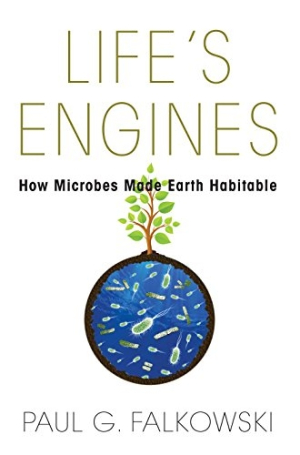Life's Engines
How Microbes Made Earth Habitable
Personal stories, hard facts, and illuminative illustrations each contribute to this engaging examination of our microbial overlords.
Our oldest ancestors are not hominids, fish with legs, or even cockroaches. No, all terrestrial life forms owe their existence to microbes. Reading Life’s Engines: How Microbes Made Earth Habitable may not cause one to add a portrait of a favorite prokaryote to the family photo album, but it is fascinating to learn how microbes evolved the complex, elegant machinery inside all our cells and made life possible on Earth.
Paul Falkowski’s decades of study in various earth and life sciences fuel this excellent addition to the Science Essentials series. His overview of microbiology and molecular biology is engaging, with a blend of hard facts and personal stories of how he became interested in science, his research projects, and his travels. Falkowski effectively uses analogies to convey abstract and complicated ideas, as when he explains how photosynthetic reaction centers work, concentrating protons on one side of a cell membrane, like the filling inside pita bread.
Many electron photographs, diagrams of the smallest microbial innards, and other illustrations illuminate dense concepts for a popular-science audience. So much has been learned since the late 20th century, when researchers began to study multispecies communities rather than cultures of microbes in isolation, making this an up-to-date overview of the subject.
The focus is on the molecular construction and chemical function of ribosomes, mitochondria, and even smaller components like coupling factors. The book also describes the role of microbes in the equilibrium of macro processes, like the continuous recycling of major elements in the earth’s crust and atmosphere. The book touches on issues of climate change, bioengineering, antibiotic resistance, resource depletion, population growth, and how microbes are affected by each and may be instrumental in undoing some of the destructive things humans have wrought. Indeed, in the event of a catastrophic event, microbes carry the core genes for the essential nanomachinery to make the earth habitable once more.
Reviewed by
Rachel Jagareski
Disclosure: This article is not an endorsement, but a review. The publisher of this book provided free copies of the book to have their book reviewed by a professional reviewer. No fee was paid by the publisher for this review. Foreword Reviews only recommends books that we love. Foreword Magazine, Inc. is disclosing this in accordance with the Federal Trade Commission’s 16 CFR, Part 255.


